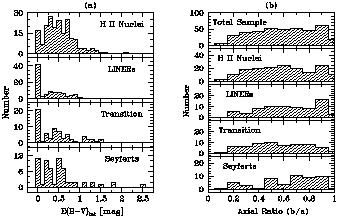


6.3. Internal Reddening and Inclination Effects
Another parameter that can be easily examined is the internal reddening along
the line of sight, as inferred from the relative intensities of the narrow
Balmer emission lines. The conventional Balmer decrement method,
unfortunately, assumes that the extinction arises from a uniform, foreground
screen of dust, and it is unclear to what extent such an oversimplified
geometry applies to the actual line-emitting regions in galaxy nuclei. The
derived reddening values, therefore, should be strictly regarded as lower
limits. With this caveat in mind, it is intriguing that LINERs are noticeably
less reddened than Seyferts (Fig. 6a;
PKS = 0.0023). That LINERs are also less reddened
compared to
transition objects is to be expected, since H II nuclei in general are much
more heavily extinguished than LINERs [median E (B - V) = 0.21
and 0.47 mag for
LINERs and H II nuclei, respectively]. These data constitute the first set of
reliable reddening measurements for such faint nuclei. In the older surveys,
the Balmer decrements were either completely unconstrained (e.g., because only
the red part of the spectrum was surveyed) or otherwise very poorly determined
because of the difficulties associated with starlight correction.
Heckman's (1980b)
suspicion that the H /
H
/
H ratios in LINERs
may be intrinsically
and abnormally high is not supported by the present observations.
ratios in LINERs
may be intrinsically
and abnormally high is not supported by the present observations.
How are these results to be interpreted? It is highly instructive to consider the axial ratios, or inclination angles, of the host galaxies for the various subclasses (Fig. 6b). Binney & de Vaucouleurs (1981) find that the distribution of apparent axial ratios (b/a) of S0s and spirals (Sa-Sd) in the RC2 is essentially flat between 0.2 and 1. The axial ratios for the entire Palomar sample, after excluding ellipticals, Magellanic irregulars (Sdm, Sm, Im), and objects with highly distorted morphologies, are shown in the upper panel of Figure 6b. Note that the distribution has a slight positive slope; this property is expected in a magnitude-limited sample, since internal absorption tends to shift edge-on systems above the limiting magnitude (Maiolino & Rieke 1995). The distributions of axial ratios among the various subclasses are quite similar, but some subtle differences can be discerned. Although Seyferts are found in hosts of all inclinations, there appears to be a preference for systems viewed more face-on (larger b/a). Such an inclination bias is well known in other samples of Seyfert galaxies (Keel 1980; McLeod & Rieke 1995; Maiolino & Rieke 1995), but it is much less pronounced in the present sample because of our ability to detect weak emission lines. There is also some indication that a similar selection effect is present in LINERs, and, at any rate, Seyferts and LINERs do not have different inclinations. Thus, from geometric considerations alone, these two groups should be equally reddened. The enhanced reddening observed in Seyferts relative to LINERs, therefore, must point to subtle, intrinsic differences present in the physical conditions of their NLRs (Section 9).

|
Figure 6. (a) Distribution of
internal reddening as measured from
H |
The axial ratios of H II nuclei and transition objects, on the other hand, appear to be evenly distributed, and do not seem to be affected by any obvious inclination bias. It is tempting to postulate that at least some transition objects are nothing more than highly-inclined LINERs. The increased path length along the line of sight to the nucleus increases the likelihood of intersecting discrete circumnuclear H II regions as well as general extended nebulosity photoionized by massive stars (see also discussion in Section 8).
I note, in passing, that the inclination bias among Seyfert galaxies in our
sample is present in Seyfert 1s and Seyfert 2s, in agreement with
McLeod & Rieke (1995) and
Maiolino & Rieke (1995),
although in our sample
and in that of Maiolino & Rieke the axial-ratio cutoff is not as pronounced
as that of the CfA Seyferts studied by McLeod & Rieke. The larger number of
high-inclination Seyferts detected compared to the CfA sample probably
reflects the much larger average distance of the latter sample. That the
absorbing material evidently affects both the broad-line region (BLR) and the
NLR implies that the source of obscuration lies in a flat configuration
aligned with the plane of the galactic disk. Based on the abrupt fall off of
objects with b/a  0.5 in the CfA sample, McLeod & Rieke argue that the
obscuring for the existence of an ``outer torus,'' whose thickness and radial
extent are comparable to the dimensions of the NLR (r
0.5 in the CfA sample, McLeod & Rieke argue that the
obscuring for the existence of an ``outer torus,'' whose thickness and radial
extent are comparable to the dimensions of the NLR (r
 100 pc).
It is unclear whether this model is applicable to the low-luminosities
sources considered here, since opacity from the dusty disk of the galaxies
alone can explain the inclination bias observed.
100 pc).
It is unclear whether this model is applicable to the low-luminosities
sources considered here, since opacity from the dusty disk of the galaxies
alone can explain the inclination bias observed.